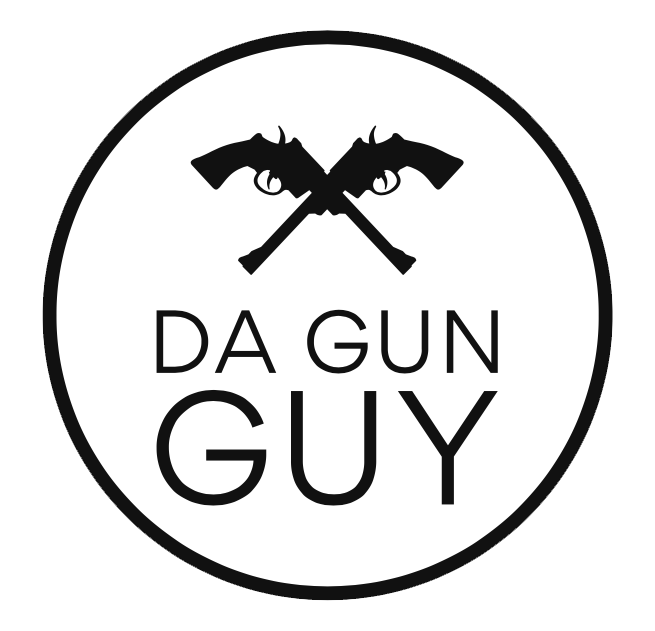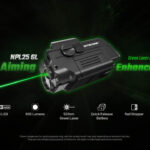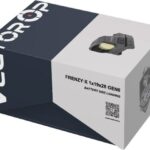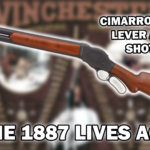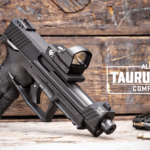Nitecore’s NEW Weapon Light/Green Laser Combo – The NPL25-GL
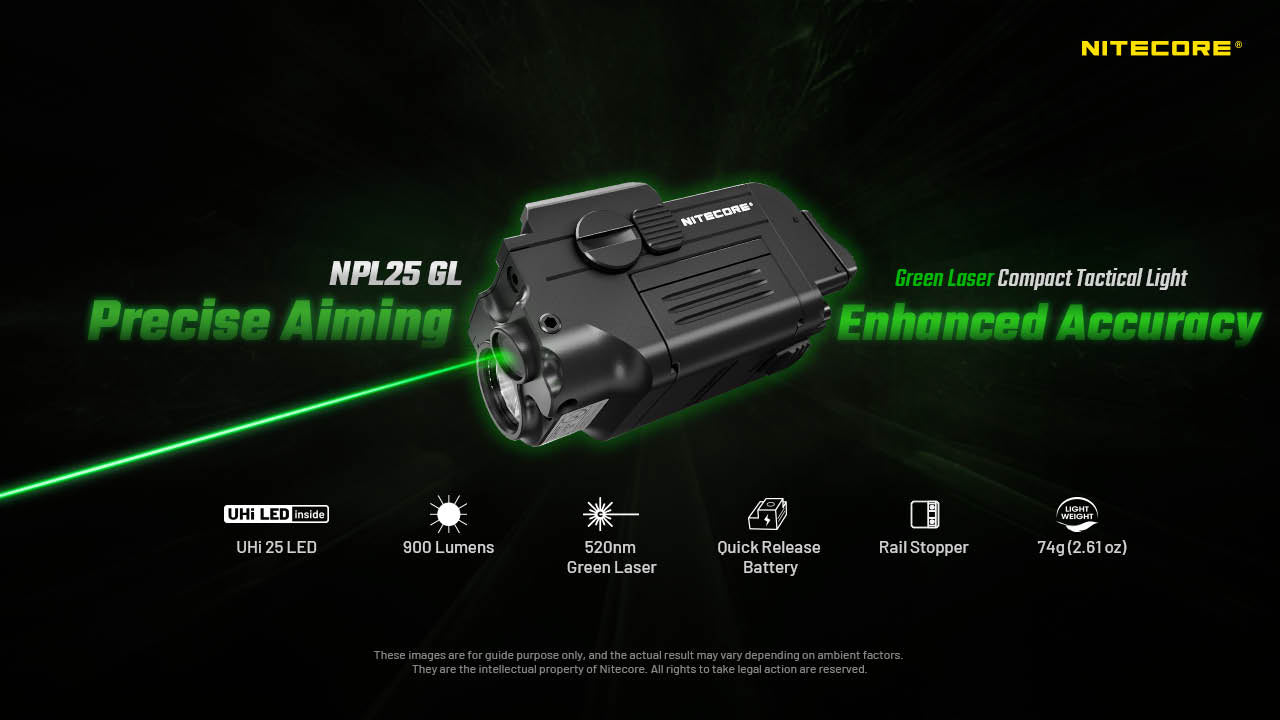
The Importance of a Weapon Light Green Laser Combo for Self-Defense: A Review of the Nitecore NPL25-GL
In the world of self-defense, preparedness means having the right tools to ensure both safety and effectiveness. One such tool, often overlooked by new firearm owners, is a weapon-mounted light and laser combo. These devices enhance your ability to identify targets in low-light conditions and improve aiming accuracy, potentially making the difference in life-threatening situations. One standout product in this category is the Nitecore NPL25-GL, which combines a powerful light and a green laser in a compact, reliable package.
Why Weapon Lights and Lasers Matter
In real-life self-defense scenarios, you are rarely operating in ideal lighting. Whether it’s in your home during a nighttime disturbance or an outdoor setting with minimal visibility, a weapon light allows you to illuminate your target and identify potential threats. This eliminates guesswork, reducing the risk of accidentally targeting a non-threat.
A laser, particularly a green one, further adds to this utility. Green lasers are highly visible to the human eye, even in brighter environments, making them ideal for both daylight and low-light scenarios. They allow for faster, more intuitive aiming, especially in high-stress situations where sight alignment may be difficult.
The Nitecore NPL25-GL: A Closer Look
The Nitecore NPL25-GL stands out as an excellent choice for firearm owners seeking a high-quality light and laser combo. Here’s why:
1. Impressive Illumination
The NPL25-GL features a high-output LED that delivers up to 900 lumens of bright, focused light. This level of brightness is more than sufficient to disorient an attacker, giving you a critical tactical advantage. The beam is also designed for wide coverage, ensuring you can scan your surroundings efficiently.
2. Bright and Accurate Green Laser
The integrated green laser operates at a <5mW output, ensuring it remains highly visible and safe for everyday use. Its position below the light allows for easy adjustment and alignment with your firearm’s sights. Whether you’re using it in daylight or dim conditions, the laser remains highly effective for quick target acquisition.
3. Durable and Compact Design
Constructed from aerospace-grade aluminum, the NPL25-GL is built to withstand the rigors of everyday carry and self-defense. It’s impact-resistant up to 1 meter and rated IPX6 water resistance, meaning it can handle rain, sweat, and other environmental challenges. Despite its durability, the unit is compact and lightweight, ensuring it won’t add unnecessary bulk to your firearm.
4. Easy Attachment and Operation
The NPL25-GL is designed to attach seamlessly to standard Picatinny or Glock-style rails. Its ambidextrous controls allow you to operate both the light and laser effortlessly, making it ideal for left- or right-handed shooters. It also features multiple modes, enabling you to customize its functionality based on your needs.
5. Battery Life and Efficiency
The Nitecore NPL25-GL is powered by a rechargeable battery, eliminating the need for disposable options like CR123A batteries. With a runtime of 35 continuous minutes, it provides ample power for short-term engagements or routine use. The rechargeable design not only reduces long-term costs but also ensures you can quickly get back to full charge when needed, making it both convenient and eco-friendly.
This reliable battery performance ensures the NPL25-GL is always ready when you need it, whether you’re training or relying on it for personal protection.
Why Choose the Nitecore NPL25-GL?
The Nitecore NPL25-GL isn’t just a light and laser—it’s a confidence booster. In high-stakes situations, you don’t have time to fumble with unreliable equipment. With its robust construction, ergonomic design, and superior performance, this combo offers the assurance you need when it matters most.
For firearm owners looking to enhance their self-defense setup, the Nitecore NPL25-GL is a practical and affordable upgrade. It combines essential tools—illumination and aiming—into a single, durable package. Whether you’re a seasoned gun owner or just starting your self-defense journey, this product deserves a place on your firearm.
Final Thoughts
In self-defense, every second counts, and every decision matters. Equipping your firearm with a weapon light and laser combo, like the Nitecore NPL25-GL, ensures you’re prepared for low-light encounters with confidence and precision. Don’t just rely on your instincts—equip yourself with the tools to see clearly and aim true.
Shooting for Old Guys (and Eyes) – VECTOR OPTICS’ FRENZY-X 1X19X28 GENII

As I find myself growing older, I have noticed, not surprisingly, my eye too are aging. And, like most folks, I’ve come to accept this and figure out work arounds into my daily routine. But, it has created some challenges for my main hobby, shooting. I’ve learned to deal with a choice of a blurry target or a blurry sight picture. (FYI I recommend the blurry target.) It has made shooting at distances over 10 yards far more challenging than it used to be some years ago. So, when I was at the Gun Owners of America’s range day this year and picked up my first pistol with a red dot (“RD”), I was surprised and pleased to see (pun intended) that I could clearly see the red dot AND target. As a result, I started exploring incorporating red dots into my shooting and into our reviews. So … here we go:
The first red dot I have ever put on one of my guns was a Vector Optics Frenzy SCRD-64. Why? Well, they sent me one to test and it hit all the things I was looking for. Although, as a new red dot shooter, I’m still trying to figure out what exactly some of those things are. But, I did like the features and the price point so let’s get into the specifications first.

Specifications:
- The SCRD-64 comes in at 1.39 oz without the weaver mount which is included in the package. It has a length of 46mm, a width of 30mm and a height of 39.5 mm).It is made out of 7075-T6 aluminum (meaning it’s pretty strong) and has a Waterproof rating of IPX7 (meaning it can be submerged in up to 3’ of water for about 30 minutes. PS: I’m not recommending to try this BUT nice to have “in case”).
- It has an MOJ footprint which is considered the same as an “RMR” footprint.
Features:
- This model comes with a 3 MOA red dot that has 11 levels of intensity. 3 MOA means that the dot with cover approximately 3” of the target at 100 yards, 1.5” of the target at 50 yards, ¾” at 25 yards and so forth. Overall, a nice size for defensive shooting and target shooting at closer distances.
- It has a side mounted battery (CR2032), which means you don’t have to re-zero every time you swap out the batteries. That’s a very nice feature. And, each battery should give you about 50,000 hours of usage. There is also a motion sensor function which works very well. It took me a bit to figure this out but basically:
- You can turn the RD on by pressing and holding the “+” button. You can turn the RD AND the motion sensor off by pressing the “-“ button. If you just let it “go to sleep” without turning it off manually, the motion sensor works like a charm.
- For purposes of zeroing the RD, it has audible 1 MOA click – this is a God send for trying to zero the dot!
- The Aspheric lens seemed clear and honestly, it was pretty easy for me to acquire the RD when shooting without any trouble.

Price:
These come in at right around $170.00 at the time I’m writing this. Which is one of the more budget friendly optics with these features that I’ve seen. One of the main reasons, I’ve held off on using RDs is I don’t like the concept of spending $350.00 to put optics on something I just spent $500.00 plus dollars on. But, it doesn’t really matter about the price point if the thing doesn’t work. So, I put it on my STR-9 and took it to the range to see: did it work? SPOILER ALERT – like a charm!
Range Time Impressions:
I found SCRD-64 incredibly easy to zero. I had a chart/target which let’s me zero for 25 yards at 5 yards and it took less than 5 minutes to zero (with the help of a laser bore – you can see the video at our YouTube or Rumble channel). The RD and laser were a bit off but with 12 audible clicks the left, I centered up the dot with the laser bore and began shooting.
In regard to the intensity of the dot, I thought I would like the RD on it’s brightest setting but actually found one of the lower settings (4 or 5) worked best for me. The dot was clean and bright enough to be very visible – even against a red bullseye. The controls for the intensity of RD were very user friendly and allowed me to find a brightness and clarity that I found most comfortable to shoot with.
Using a rest to test the accuracy, I found that I could get sub 1” groups out to 10 yards and 6” groups at 25”. Also, it was very easy for me to acquire the dot, even when moving to different targets. Moving on to normal shooting, I still found I could get very nice groups, much further out and much faster than I normally could with iron sights. Having struggled with vision and shooting for the last several years, I don’t think I can adequately express how nice it was to shoot with this RD and be able to focus (again pun intended) on the mechanics of shooting as opposed to just trying to see.
Final Thoughts:
While I haven’t had tons of time shooting red dots or tons of experience with different models/brands, I can honestly say I really enjoyed shooting the FRENZY-X 1X19X28 GENII and would recommend it. As always, I’d be interested to hear your thoughts or feedback on both this article and our video – which you can see at our Youtube channel shortly.
The Legacy of Cimarron Firearms & The 1887 Shotgun

SEE OUR FULL VIDEO REVIEW ON YOUTUBE: CLICK HERE FOR OUR VIDEO REVIEW
A Glimpse into the Old West
Cimarron Firearms has established itself as a leading name in the world of replica firearms, bringing the spirit of the Old West to life with unparalleled authenticity. Founded in 1984 by Mike Harvey in Fredericksburg, Texas, Cimarron has focused on producing high-quality replicas of historical firearms, particularly those from the American frontier period. The company’s dedication to detail and historical accuracy has made it a favorite among collectors, reenactors, and cowboy action shooters.
The Birth of Cimarron Firearms
Cimarron Firearms was born out of Harvey’s passion for the guns of the Old West. His goal was to create replicas that were not just functional but also visually and historically accurate. Harvey began by importing firearms from Italian manufacturers like Uberti and Davide Pedersoli, known for their craftsmanship in reproducing historical weapons. However, what set Cimarron apart was their insistence on improving the quality and authenticity of these imports. Harvey worked closely with these manufacturers, providing them with original antique firearms to ensure that every detail, from the dimensions to the markings, matched the originals.
Cimarron quickly gained a reputation for producing some of the finest replicas of historical firearms. The company’s offerings range from iconic revolvers like the Colt Single Action Army, also known as the “Peacemaker,” to lever-action rifles and shotguns that were staples of the American West. Cimarron’s commitment to authenticity extends to their use of period-correct finishes, grips, and markings, making their firearms nearly indistinguishable from the originals.
Cimarron’s 1887 Winchester Shotgun Clone
One of the standout offerings from Cimarron is their replica of the Winchester Model 1887 shotgun, a firearm that holds a special place in the history of American firearms. The original Model 1887 was designed by the legendary John Moses Browning and was one of the first successful repeating shotguns. It was produced by Winchester Repeating Arms Company and was notable for its lever-action mechanism, which was more commonly associated with rifles at the time.
The Cimarron 1887 Winchester clone is a faithful reproduction of this iconic shotgun, capturing the look and feel of the original while incorporating modern manufacturing techniques to ensure reliability and performance. Here’s a closer look at its technical specifications:
- Caliber: The Cimarron 1887 is available in 12-gauge, staying true to the most common chambering of the original Model 1887.
- Capacity: It features a 5-round tubular magazine, allowing for quick follow-up shots.
- Barrel Length: The shotgun is offered with a 20-inch barrel, which provides a balance between maneuverability and accuracy.
- Overall Length: The total length of the Cimarron 1887 is approximately 39 inches, making it a compact and versatile option for various shooting activities.
- Weight: The shotgun weighs around 8 pounds, which is close to the weight of the original, giving it a solid and authentic feel.
- Finish: Cimarron offers this shotgun with a blued finish on the barrel and receiver, paired with a walnut stock and forend. The wood is finished to a period-correct standard, adding to the overall authenticity.
- Action: The lever-action mechanism is smooth and reliable, with a design that closely mimics the original Model 1887. This shotgun also features a top-eject system, just like its historical predecessor.
A Piece of Living History
Cimarron Firearms has done an exceptional job of bringing the past to the present with their 1887 Winchester shotgun clone. This firearm is not only a tribute to John Browning’s genius but also a testament to Cimarron’s commitment to preserving the legacy of the Old West. Whether you’re a collector, a cowboy action shooter, or simply a fan of historical firearms, the Cimarron 1887 offers a unique opportunity to own and experience a piece of living history.
In conclusion, Cimarron Firearms has carved out a niche for itself by producing some of the most authentic and high-quality replicas of historical firearms on the market. Their 1887 Winchester shotgun clone is a perfect example of their dedication to craftsmanship and historical accuracy. As long as there are enthusiasts who appreciate the firearms of the Old West, Cimarron will continue to thrive as a premier name in the world of replica firearms.
The Bersa TPR9c
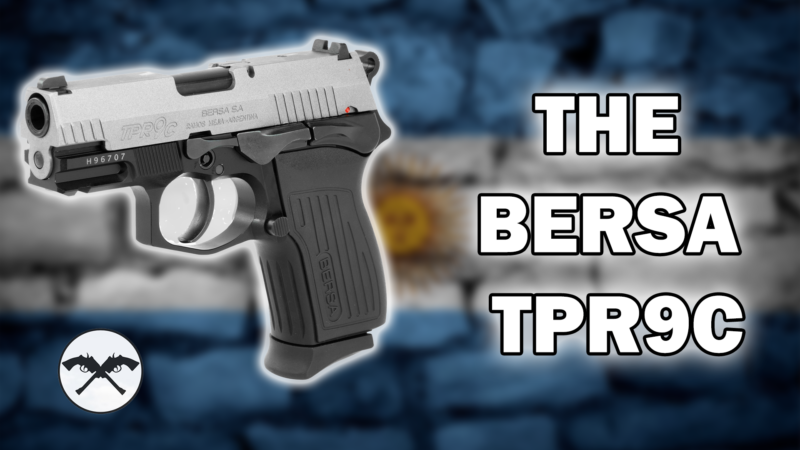
To see our full video review click here: CLICK HERE FOR OUR VIDEO REVIEW
The History of Bersa Firearms
Bersa, an Argentinian firearms manufacturer, has a rich history that dates back to 1958. Founded by three Italian immigrants—Bessano, Ravasio, and Savino—Bersa quickly gained recognition for producing reliable and affordable firearms. The company’s name is a blend of the founders’ surnames, which signifies their collaboration and shared vision of creating quality firearms for both civilian and military use.
Early Years and Expansion
Bersa began its journey by manufacturing a .22 caliber handgun modeled after the German Walther PP. This initial success allowed the company to expand its product line, leading to the development of various semi-automatic pistols, which became popular due to their affordability and dependability.
During the 1980s, Bersa gained prominence in the international market with the introduction of the Bersa Thunder series, a line of pistols that offered excellent performance at a reasonable price. The Thunder series, particularly the Thunder 380, became a favorite among concealed carry permit holders due to its compact size, reliability, and manageable recoil.
Bersa’s Place in the Global Market
Bersa’s commitment to quality and affordability allowed the company to compete with more established brands in the global firearms market. The company’s firearms are widely used by law enforcement agencies in Argentina and have a growing presence in the U.S. market, thanks to their reputation for reliability and value.
The evolution of Bersa firearms is marked by continuous innovation. The company has expanded its offerings to include more modern designs, catering to the needs of both civilian and professional users. This includes the TPR (Thunder Pro) series, which has become known for its robust build and performance-oriented features.
Technical Specifications of the Bersa TPR9c
The Bersa TPR9c, part of the Thunder Pro series, is a compact, high-capacity 9mm pistol designed for concealed carry and personal defense. It combines the compact size and ease of concealment of the Thunder series with the durability and reliability that Bersa is known for.
Key Specifications:
- Caliber: 9mm
- Capacity: 13+1 rounds
- Barrel Length: 3.25 inches
- Overall Length: 6.5 inches
- Height: 5.1 inches
- Width: 1.45 inches
- Weight: 23 ounces (unloaded)
- Frame Material: Aluminum alloy
- Slide Material: Steel
- Finish: Matte black or nickel
- Sights: Interchangeable Sig Sauer type
- Trigger: DA/SA (Double Action/Single Action)
- Safety: Manual safety, decocker, and firing pin block
Performance and Features
The TPR9c is praised for its smooth trigger pull, which is a hallmark of Bersa’s design. The DA/SA trigger system provides flexibility, with a heavier first pull in double-action mode and a lighter, more precise pull in single-action mode. This feature is particularly useful for those who prefer the added safety of a longer first pull.
The pistol’s aluminum alloy frame makes it both lightweight and durable, while the steel slide ensures strength and longevity. The TPR9c also comes equipped with an interchangeable sight system, allowing users to customize their sight picture to their preference. The pistol’s ergonomics are well thought out, with a comfortable grip that accommodates a variety of hand sizes.
The TPR9c’s compact size and manageable weight make it an ideal choice for concealed carry, while its 13-round capacity provides ample firepower. The safety features, including a manual safety, decocker, and firing pin block, offer an added layer of security, making the TPR9c a reliable choice for personal defense.
Conclusion
Bersa’s legacy in the firearms industry is built on a foundation of quality, affordability, and reliability. The TPR9c exemplifies these traits, offering a compact, high-capacity option for those in search of a dependable 9mm pistol for concealed carry. With its robust construction, thoughtful design, and user-friendly features, the TPR9c is a testament to Bersa’s ongoing commitment to producing firearms that meet the needs of today’s shooters.
A Budget Friendly Competition Gun

The Taurus TX22 Competition is a specialized variant of the popular TX22 model, tailored for competitive shooting. Let’s explore its features in detail and compare it to other competitive handguns on the market.
Specifications:
- Weight: The TX22 Competition maintains a lightweight design, similar to the standard TX22, weighing around 17.3 ounces.
- Height: Its height remains around 5.44 inches, providing a comfortable grip and control during competitions.
- Length: The overall length of the TX22 Competition is approximately 7.06 inches, offering a balanced feel and easy handling on the range.
- Trigger Pull: One of the key improvements in the TX22 Competition is its enhanced trigger pull. It features a lighter and crisper trigger with a weight of around 3.5-4 pounds, contributing to improved accuracy and faster follow-up shots.
Optics Compatibility: The TX22 Competition comes with an optics-ready slide, allowing shooters to easily mount red dot sights or other optical accessories. This feature enhances target acquisition speed and precision, making it ideal for competitive shooters who rely on quick and accurate aiming.
Comparison with Other Models:
- Ruger Mark IV: The Ruger Mark IV is a strong competitor in the competitive shooting scene. It weighs slightly more than the TX22 Competition, around 25 ounces, and has a longer overall length of approximately 9.75 inches. Its trigger pull can vary but is generally in the range of 4.5-5.5 pounds. This gun sells online starting at around $400.00.
- Smith & Wesson Victory: The S&W Victory is comparable to the TX22 Competition in weight and length, with a similar trigger pull weight of around 4 pounds. However, it may require aftermarket modifications for optics mounting. This gun sells online starting at around $380.00.
- Browning Buck Mark: The Browning Buck Mark is another contender with a weight of around 34 ounces and a longer overall length of about 9.5 inches. Its trigger pull is typically in the range of 4-5 pounds, similar to the TX22 Competition. This gun sells online starting at around $410.00.
Price: As of my last update, the Taurus TX22 Competition is competitively priced in the market for competition-grade handguns. You can find it online for around $335 to $450, depending on the retailer and any ongoing promotions.
In conclusion, the Taurus TX22 Competition offers competitive shooters a lightweight, optics-ready platform with an improved trigger for enhanced performance on the range. Its features make it a strong contender against other popular models like the Ruger Mark IV, Smith & Wesson Victory, and Browning Buck Mark, providing a cost-effective option for those seeking a reliable and accurate competition handgun.
John Wick’s First Handgun!
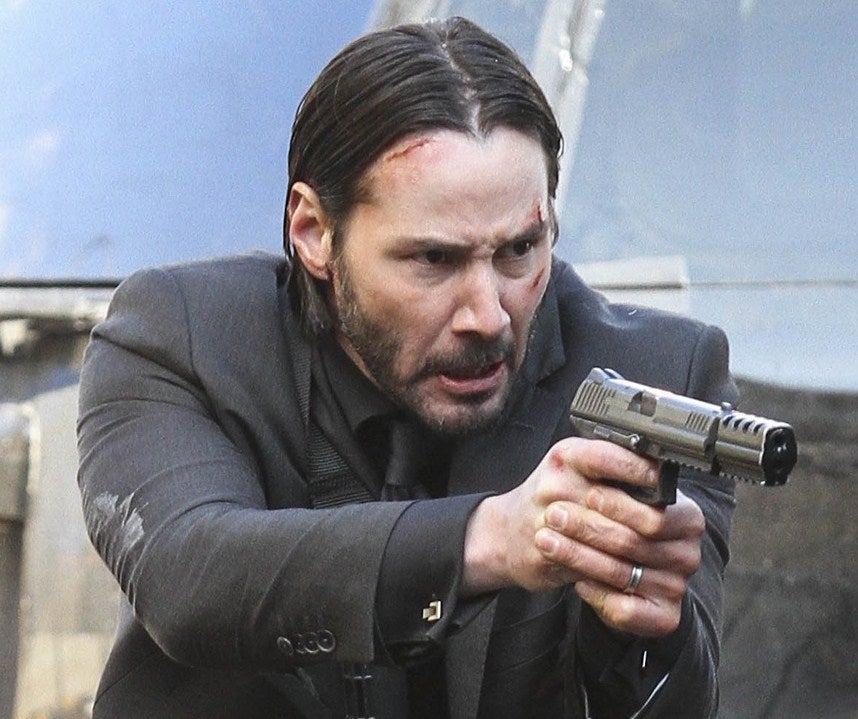
The HK P30L V3 is a hammer fired handgun that has gained significant attention and popularity, partly due to its appearance in the first John Wick movie. This pistol has become a favorite among enthusiasts and professionals alike, thanks to its exceptional performance and innovative design features.
See our full video review of this gun @ Youtube https://youtu.be/k1d5YitdgoY?si=q3mZbFPJv-bMsxhD
Let’s delve into some statistical information about the HK P30L V3:
- Caliber: The HK P30L V3 is available in multiple calibers, including 9mm and .40 S&W, offering versatility to shooters based on their preferences and needs.
- Capacity: This pistol typically comes with a magazine capacity of 15 rounds for 9mm and 13 rounds for .40 S&W, providing ample firepower for various shooting scenarios.
- Barrel Length: The P30L variant features a longer barrel compared to the standard P30 model, measuring approximately 4.45 inches. This extended barrel enhances accuracy and ensures better control during shooting.
- Trigger System: The V3 variant of the HK P30L utilizes a unique trigger system that combines a light single-action trigger pull with a short reset, enabling quick and precise follow-up shots. This feature is highly valued by competitive shooters and those who prioritize speed and accuracy.
- Safety Features: HK is known for its stringent safety standards, and the P30L V3 is no exception. It includes multiple safety mechanisms such as a firing pin block, manual safety lever, and a decocking button, ensuring safe handling and operation.
For those who prefer a striker fire gun, HK has come out with the HK VP9.
Let’s dive into the comparison between the HK P30L V3 and the HK VP9, highlighting their key differences and similarities, as well as explaining the distinction between striker-fired and hammer-fired handguns.
HK P30L V3 vs. HK VP9:
- Action Type:
- HK P30L V3: The P30L V3 is a hammer-fired handgun, meaning it utilizes a hammer mechanism to strike the firing pin and ignite the cartridge.
- HK VP9: The VP9, on the other hand, is a striker-fired handgun. This means it uses a striker mechanism directly linked to the trigger to ignite the cartridge.
- Striker-Fired:
- Striker-fired handguns have a simpler internal mechanism where the trigger directly activates a striker (a firing pin) to ignite the cartridge.
- They often feature consistent trigger pulls and are known for their reliability and ease of use.
- Examples include the HK VP9, Glock pistols, and many modern semi-automatic handguns.
- Hammer-Fired:
- Hammer-fired handguns have a more complex mechanism where the trigger interacts with a hammer, which in turn strikes the firing pin to fire the round.
- They may offer both double-action and single-action trigger modes, providing versatility in shooting styles.
- Examples include the HK P30 series, CZ 75, and Beretta 92 series.
- Striker-Fired:
In summary, the HK P30L V3 and HK VP9 represent two excellent options from Heckler & Koch, each with its unique action type and features. Understanding the differences between striker-fired and hammer-fired handguns can help shooters choose the firearm that best suits their preferences, shooting style, and intended use.
The Walther PPK: A Modern CCW Weapon for Concealed Carry

Introduction: When it comes to choosing a reliable and effective concealed carry weapon (CCW), the Walther PPK has earned its place in the spotlight. With its compact design, renowned reliability, and iconic status, the Walther PPK is a popular choice among those seeking a discreet and powerful self-defense option. In this blog post, we’ll explore the reasons behind its reputation as a modern CCW weapon.
- Compact Size and Comfort: One of the primary considerations for a concealed carry weapon is its size, and the Walther PPK excels in this aspect. With its slim profile and shorter barrel length, it offers a comfortable and discreet fit when concealed on your person. This compactness allows for easy concealment, be it in an inside-the-waistband holster or an ankle carry setup.
- Reliability and Performance: The Walther PPK is known for its outstanding reliability and performance. Originally designed for law enforcement and civilian use, this semi-automatic pistol has a proven track record of dependability. Its robust construction and quality materials ensure smooth functioning, providing peace of mind knowing that it will operate reliably in critical situations.
- Ergonomics and Handling: The PPK’s ergonomic design and intuitive controls make it an excellent choice for concealed carry. With its comfortable grip and well-placed controls, including a manual safety and decocker, it offers a user-friendly experience. This means easier operation, quick target acquisition, and a reduced learning curve for both experienced shooters and those new to concealed carry.
- Chambering and Caliber Options: The Walther PPK is available in various chamberings to suit personal preferences and local regulations. Originally chambered in .32 ACP, it is also available in .380 ACP (9mm Kurz in Europe) for those desiring added stopping power. The availability of different chamberings allows individuals to select the appropriate caliber based on their comfort, proficiency, and specific self-defense needs.
- A Legacy of Excellence: The Walther PPK’s legacy dates back to its introduction in the 1930s, and its reputation has only grown stronger over time. Its association with James Bond has heightened its allure, capturing the imagination of gun enthusiasts and casual fans alike. This legacy of excellence ensures the Walther PPK remains a sought-after CCW weapon.
Conclusion: When it comes to concealed carry weapons, the Walther PPK, while not as updated as many new carry guns, stands as a reliable, compact, and effective choice. Its compact size, reliable performance, ergonomics, and caliber options make it a popular selection for those who prioritize discreet self-defense. As always, responsible ownership, regular training, and adherence to the law are crucial factors to consider when carrying any firearm.
My 1st CCW: Ruger’s SR22
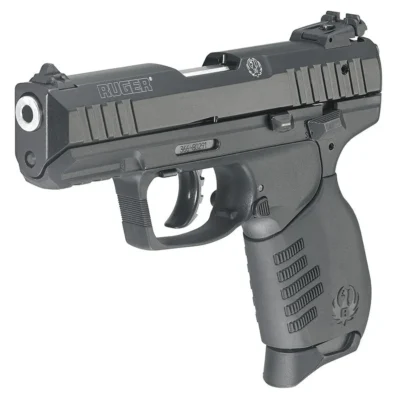
So many years ago, I wanted to get my conceal carry license. I hadn’t shot a gun in a long long time. I had several large caliber guns but was worried about the qualifying portion of the CCW test. My understanding was we’d have to have a 90% accuracy with a time limit. The thought of acquiring my target 9 out of 10 times with a stopwatch clicking after my gun kicked every shot seemed nerve wrecking.
The answer: why not qualify with a .22? I shot those as a kid and if the 8 year old me could handle it, the “38” year old me should have no problem. So, I started looking at semi-automatic 22s. Hands down, the Ruger SR-22 jumped out.
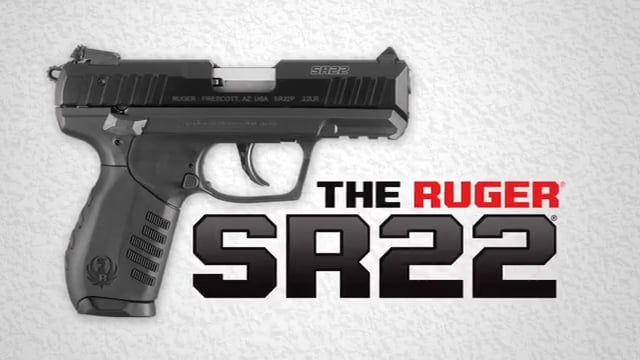
There were several reasons (and these reasons usually always apply when I’m looking at a new gun for my collection):
Price: I believe I paid somewhere in the neighborhood of $350.00 for the gun – fair enough.
Capacity: 10 + 1. More than enough so I wasn’t reloading under pressure to qualify (We had to center mass 27 out of 30) – so 3 mags and I’m good. HUGE PLUS – the gun came with two 10 round magazines.
Sights: Very visible adjustable 3-dot sights.
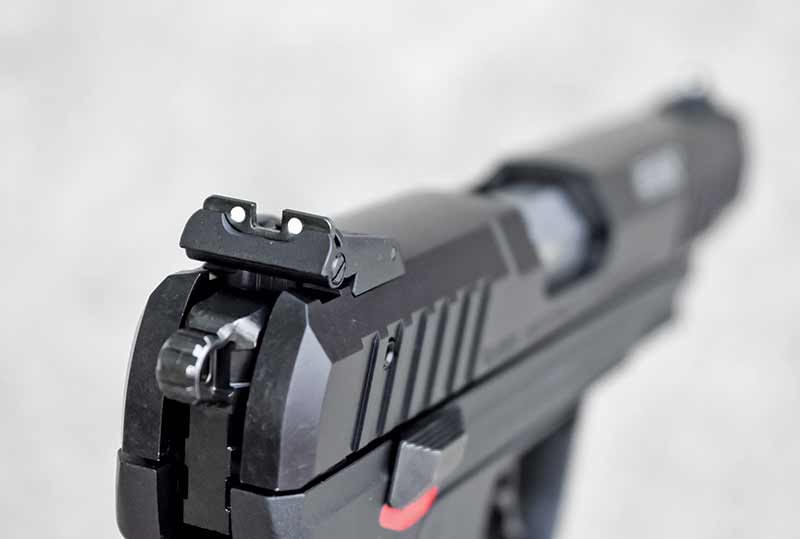
Action: Super smooth. Light double action with a nice crisp SA trigger pull.
Hammer: External hammer (I really like an external hammer as opposed to not having one or striker fire – more on this in future posts!)
Safety: I like having a safety on my guns. This gun has an ambidextrous thumb safety AND a de-cocking lever (also one of my favorite add-ons).
Recoil: Practically non-existent!
Lastly, the gun is pretty small and lightweight. It weighs 17.5 oz (unloaded) and had and overall length of 6.4″; height of 4.9″; and, width of .97″. A wee bit too big for a pocket carry but easy enough for other ways to carry. (Yes, I realize 22LR is not really anybody’s choice caliber to carry – but hey, if you had to …)
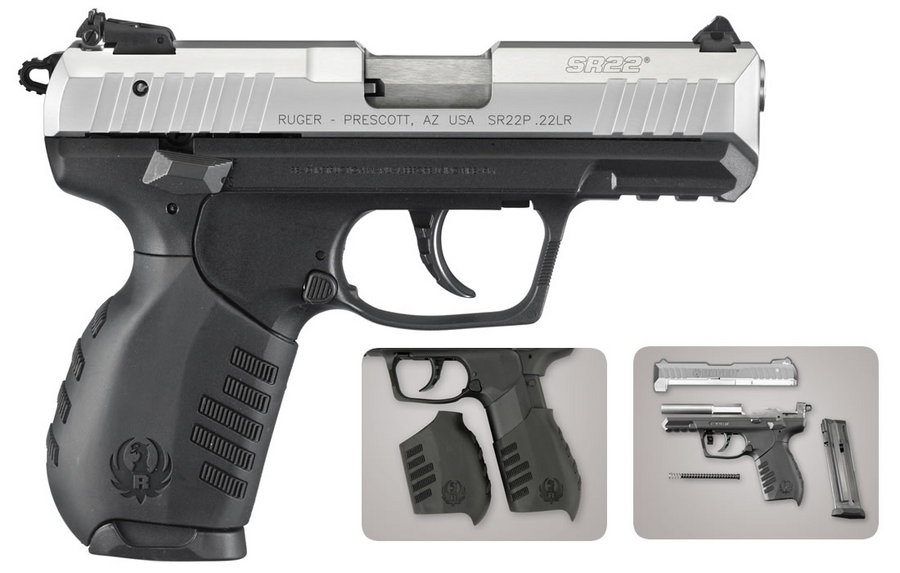
Needless to say, I bought this gun, used it to qualify and LOVE to take it out and plink at the range every once and awhile. It’s a great overall gun. This is the gun I let friends who have never shot use. It llets them get used to the mechanics of firing a weapon without the jolt of a .357 or .45. It’s the gun I use to teach my daughter with and HIGHLY recommend getting one if you’re looking at 22s.
